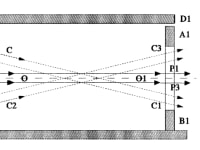Compact “parallel” beam on the sample in optical spectrometers
The measurement of the absorbance of a sample in most of the optical spectrometers (UV, vis, IR) presently is carried out by using a focused, or convergent beam , having a small size focus in the sample compartment where the sample is positioned, see Fig.1. Such beam configuration follows from the necessities of gathering as much energy as possible from the source using large mirrors and allowing the measurement of small samples. This configuration entails several disadvantages:
1. When the sample is not thin in the direction parallel to the beam axis (single pass gas cells, Dewar-type cells for high or low temperature samples, low absorbing liquids...), the diameter of the windows (made of generally expensive material, different according to the wavelength range of interest) increases linearly with the sample thickness, involving high costs and fragility.
2. The measured absorbance for the same sample is different for different instruments, depending on the f/ number of the beam. Low f/ numbers entail larger fractions of rays out-of-axis by larger angles; the optical path of a ray r is proportional to (cos ζr)–1, with ζr the angle ray-optical axis. The same sample shows a larger absorbance if the f/ number of the beam is small.
3. When the sample is a crystal not belonging to the cubic system, or an oriented crystalline film optically equivalent, even when the beam axis is parallel to an optical axis, all the other rays will be tilted to the optical axis, generating extraordinary rays with the effect of modifying the measured dichroism.
In a patent I showed that a compact (that is small diameter), collimated (that is nearly parallel) beam configuration provides a satisfactory solution for all the above problems.
With reference to Fig.2, the compact (C-D) collimated beam can be obtained directly from the large diameter A-B collimated beam. In Fourier transform spectrometers the beam exiting the interferometer is generally a large diameter collimated beam, which can be directly changed into a small diameter beam as shown in Fig.2.
But this would involve a considerable change of the present spectrometer’s optics, best made when the instrument is built, or its optics designed, and would result in cost reduction. If a spectroscopist should be interested to get a compact collimated beam in the sample compartment without modifying the optical system of an existing spectrometer, the modification of the beam can be left to an accessory of modest cost to be placed in the sample compartment, as outlined in Fig.3.
It consists of a symmetrical arrangement of four mirrors: The plane mirror PL1 deflects laterally the beam and the off-axis parabolic mirror (even an optimized toroidal mirror would work) PA1 converts the converging beam into a compact collimated beam, which passes through the sample SA and is returned to its prior divergent status going to the detector by the off-axis parabolic mirror PA2 and the plane mirror PL2.
References and notes
Like this entry?
-
About the Entrant
- Name:Bruno Lunelli
- Type of entry:individual
- Software used for this entry:MSOffice, MSOffice Picture Manager
- Patent status:patented








